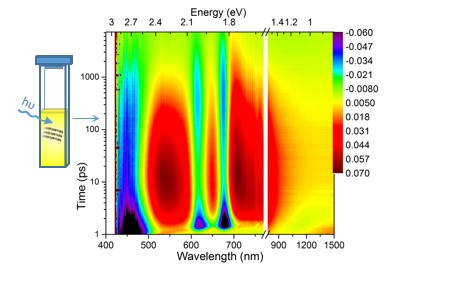Planar Carbon Lattices
RTG-2861-PCL
C3 - Multidimensional (1D and 2D) spectroscopy of charge carriers within PCL
Principal investigator: Prof. Dr. Dirk Guldi, FAU Erlangen, [webpage]
Doctoral researcher in the 1st cohort: Elena Mack
Doctoral researcher in the 2nd cohort: Open position
In PCLs, one or more spatial dimensions are small enough to confine the electronic state wave function and to give rise to unprecedented charge transfer chemistry. Besides structural, electronic, and optical properties we aim to understand and control also the catalytic activity of doping states and defects. What is relevant in the context of electronic and optoelectronic devices are properties that range from metallic as well as semiconducting to insulating and even superconducting ones. In time-resolved, 1D spectroscopy, the absorption spectrum sheds light onto excitation energies and transitions as a function of a single pump. 1D electronic absorption spectroscopy (1D–EA) is a key method to study PCLs (Figure). To push this field beyond the state-of-the-art will require multidimensional spectroscopies. The laser pulses in 2D–IR and 2D–EA allow us to label the vibronic degrees of freedom in various PCLs and to therein follow correlated events with high temporal resolution.

Figure: Visualization of multi-body dynamics in MoS2 dispersion by means of 1D-EA spectroscopy.
Our vision is to demonstrate how a number of revolutionary steps in the areas of topological graphene nanoribbons (TGNRs), covalently patterned graphene materials, and π-conjugated MOFs close the gap in our understanding of charge trapping, charge transport next to excitons, charged excitons, defect-bound localized excitons, biexcitons, etc. An important objective will be to establish a correlation between the possible hybridization of excitonic states and environment by, for example, differentiating between the optical response of monolayers versus naturally or artificially stacked (multi)layers. Likewise, the nature, position, and density of local defects, the charge population will be probed among others. All of the aforementioned will, in concert, enable handling PCLs and engineering thereof with respect to fine-tuning their optoelectronic properties.
Thesis topic 1st cohort: Excitons, biexcitons, trions and their trapping in PCLs
The focus of the project is set on using 1D- and 2D-EA spectroscopy to probe multi-body effects in PCLs, their chemical as well as photochemical generation, and their dynamics across different timescales.
Thesis topic 2nd cohort: TBA
[2] M.E. Ragoussi, J. Malig, G. Katsukis, B. Butz, E. Spieker, G. de la Torre, T. Torres, D. M. Guldi, “Linking Photo- and Redoxactive Phthalocyanines Covalently to Graphene”, Angew. Chem. Int. Ed. 2012, 51, 6421-6425.
[3] R. Canton-Vitoria, T. Scharl, A. Stergiou, A. Cadranel, R. Arenal, D. M. Guldi, “Ping-Pong Energy Transfer in Covalently Linked Porphyrin-MoS2 Architectures”, Angew. Chem. Int. Ed. 2020, 59, 3976-3981.
